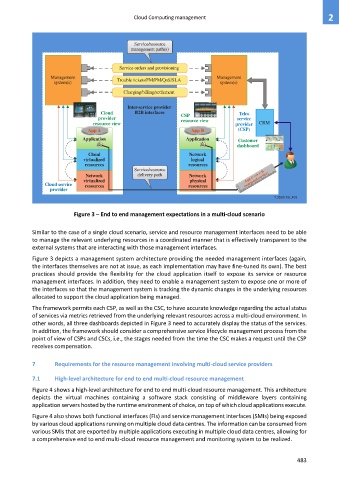Page 491 - Cloud computing: From paradigm to operation
P. 491
Cloud Computing management 2
Service/resource
management path(s)
Service orders and provisioning
Management Management
system(s) Trouble tickets/FM/PM/QoS/SLA system(s)
Charging/billing/settlement
Inter-service provider
Cloud B2B interfaces Telco
provider CSP service
resource view resource view provider CRM
App A App B (CSP)
Application Application Customer
dashboard
Cloud Network
virtualized logical
resources resources
Service/resource
Network delivery path Network App C = A + B
virtualized physical (composed service)
Cloud service resources resources
provider
Y.3520(13)_F03
Figure 3 – End to end management expectations in a multi-cloud scenario
Similar to the case of a single cloud scenario, service and resource management interfaces need to be able
to manage the relevant underlying resources in a coordinated manner that is effectively transparent to the
external systems that are interacting with those management interfaces.
Figure 3 depicts a management system architecture providing the needed management interfaces (again,
the interfaces themselves are not at issue, as each implementation may have fine-tuned its own). The best
practices should provide the flexibility for the cloud application itself to expose its service or resource
management interfaces. In addition, they need to enable a management system to expose one or more of
the interfaces so that the management system is tracking the dynamic changes in the underlying resources
allocated to support the cloud application being managed.
The framework permits each CSP, as well as the CSC, to have accurate knowledge regarding the actual status
of services via metrics retrieved from the underlying relevant resources across a multi-cloud environment. In
other words, all three dashboards depicted in Figure 3 need to accurately display the status of the services.
In addition, the framework should consider a comprehensive service lifecycle management process from the
point of view of CSPs and CSCs, i.e., the stages needed from the time the CSC makes a request until the CSP
receives compensation.
7 Requirements for the resource management involving multi-cloud service providers
7.1 High-level architecture for end to end multi-cloud resource management
Figure 4 shows a high-level architecture for end to end multi-cloud resource management. This architecture
depicts the virtual machines containing a software stack consisting of middleware layers containing
application servers hosted by the runtime environment of choice, on top of which cloud applications execute.
Figure 4 also shows both functional interfaces (FIs) and service management interfaces (SMIs) being exposed
by various cloud applications running on multiple cloud data centres. The information can be consumed from
various SMIs that are exported by multiple applications executing in multiple cloud data centres, allowing for
a comprehensive end to end multi-cloud resource management and monitoring system to be realized.
483

